Amphibians in Madagascar
Part 2 – Microhylidae and Ranidae
The uniqueness of amphibians in Madagascar is that almost all of the approximately 200 species of frogs there are endemic.
According to estimates by two specialists in the amphibian world of Madagascar, Frank Glaw and Miguel Vences, the classification of more than 150 of the frogs is still unclear.
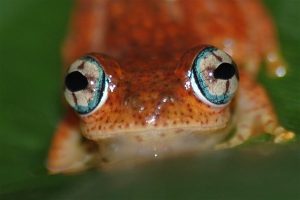
Discover these two of the largest frogs in Madagascar in the depths of the rainforest.
Among the most beautiful and colorful frogs in Madagascar are the golden Mantellas and the Microhylidae of the genus Scaphiophryne.
One particularly attractive species is the Scaphiophryne gottlebei, found in the region of the Isalo National Park.
Unfortunately, its colorful appearance makes it a target for the amphibian trade, putting it at risk.
The beauty of this frog species is therefore deadly for them.
The environmental organization Pro Wildlife raises awareness about the threat to Madagascar’s biodiversity.
The legal prohibition of trade in endangered amphibian and reptile species is crucial to their protection. The Amphibian Population of Madagascar consists exclusively of frogs. There are 311 named frog species in Madagascar, but several hundred have been identified using DNA barcoding and still need to be formally described. Native described species belong to four different families, two of which are discussed in Frogs – Amphibians in Madagascar Part 1: Hyperoliidae (11 species), Mantellidae (212 species). In this Amphibians in Madagascar Part 2, Microhylidae (86 species) and Ranidae (1 species) will be discussed. This was already discussed in the Species Protection Commission of the Washington Convention on International Trade in Endangered Species of Wild Fauna and Flora in 2009. Art.
as well as two other species described: the ranid frog Hoplobatrachus tigrinus and the toad Duttaphrynus melanostictus.
The Microhylidae
The Microhylidae, commonly known as narrow-mouthed frogs, are a geographically widespread family of frogs. The 683 species belong to 63 genera and 11 subfamilies worldwide, representing the largest number of genera of all frog families.
 Evolution
Evolution
The most recent common ancestor of the Microhylidae and their closest ranoid relatives lived approximately 116 million years ago in Gondwana.
Description
As the name suggests, they have small mouths and are generally small in size. They are known for their diverse range of habitats and unique reproductive behaviors.
Microhylids are usually small frogs. Many species are less than 1.5 cm long, although some species can grow up to 9 cm in size.
They can be arboreal or terrestrial, and some even live near water. Ground-dwelling species are often found under leaf litter in forests, occasionally venturing out at night to hunt.
The two main forms for microhylids are broad bodies and narrow mouths, and normal frog proportions.
Those with narrow mouths generally feed on termites and ants, while others have a diet typical of most frogs.
Frog breeding habits vary greatly.
Almost all. Indigenous species are endemic, with the exception of Ptychadena mascareniensis. 85 species are threatened with extinction, nine of which are classified as critically endangered by the IUCN.
Their numbers are largely affected by significant habitat changes due to deforestation and the expansion of rice fields and villages, and to a lesser extent by illegal international trade.
Anilany helenae
Anilany helenae is a species of frog from the microhylid subfamily Cophylinae. It is the only species in the monotypic genus Anilany and is endemic to Central Madagascar.
 Taxonomy
Taxonomy
This species was originally described in 2000 by Denis Vallan as a member of the genus Stumpffia.
In 2016, it was transferred to the genus Rhombophryne by Peloso et al. when they synonymized Stumpffia with this genus, but was then moved to the newly established genus Anilany by Scherz due to its genetic relationship.
Habitat and Ecology
Its natural habitat is subtropical or tropical moist montane forests. It is threatened by habitat loss.
It is now found in some strips of fragmented habitat near Ambohitantely in Madagascar.
Anodonthyla jeanbai
Anodonthyla jeanbai is a tree-dwelling frog species from the family. belongs to the Microhylidae family. It is highly polychromatic and occupies an extremely isolated phylogenetic position, showing no clear relationships with other members of the Anodonthyla genus.
It is only found in a small high-altitude area in Madagascar.
 Description
Description
Specimens in life, in dorsolateral and ventral views, all from the Andohahela National Park.
Jeanbai can be distinguished from all other Anodonthyla species in numerous ways, including a yellowish coloration on the ventral surfaces, which extends fully over the venter in some specimens.
Another distinguishing feature is the tympanum, which.
Often not as clearly visible as in other species.
In this species, the back and the rear part of the head are almost uniformly brown in color. The front part of the head has a slightly lighter brown color.
A narrow midline runs from the tip of the snout to the cloaca on the back. The inguinal region contains two black spots.

The cloacal region has a dark color, while the chest, ventral parts of the limbs, and throat have a dirty yellowish color.
The belly of this species has a similar color, but is more grayish.
A.jeanbai is an extremely polychromatic species. In life, the back is light brown. The dorsal surfaces of both the arms and legs are light reddish-brown and all have some indistinct, irregularly shaped, darker markings.
Distribution
Views of the palms of the male specimen, showing details of the first finger and prepollex.
The species has only been found at a single surveyed location at relatively high altitude in the Andohahela National Park.
found at the southern end of Madagascar in the Toliara Province.
Habitat
This species is found in higher elevations, in forests with a high density of bamboo. They are typically seen at night, 1 to 2 meters high on bamboo stems.
Etymology
This species is named after the Malagasy herpetologist Jean Baptiste (Jean-Ba) Ramanamanjato. He provided logistical information that was a crucial part of the expedition to the type locality located in higher elevations, an area of the Andohahela National Park.
Anodonthyla nigrigularis
Anodonthyla nigrigularis is a frog species from the Microhylidae family. It is endemic to Madagascar.
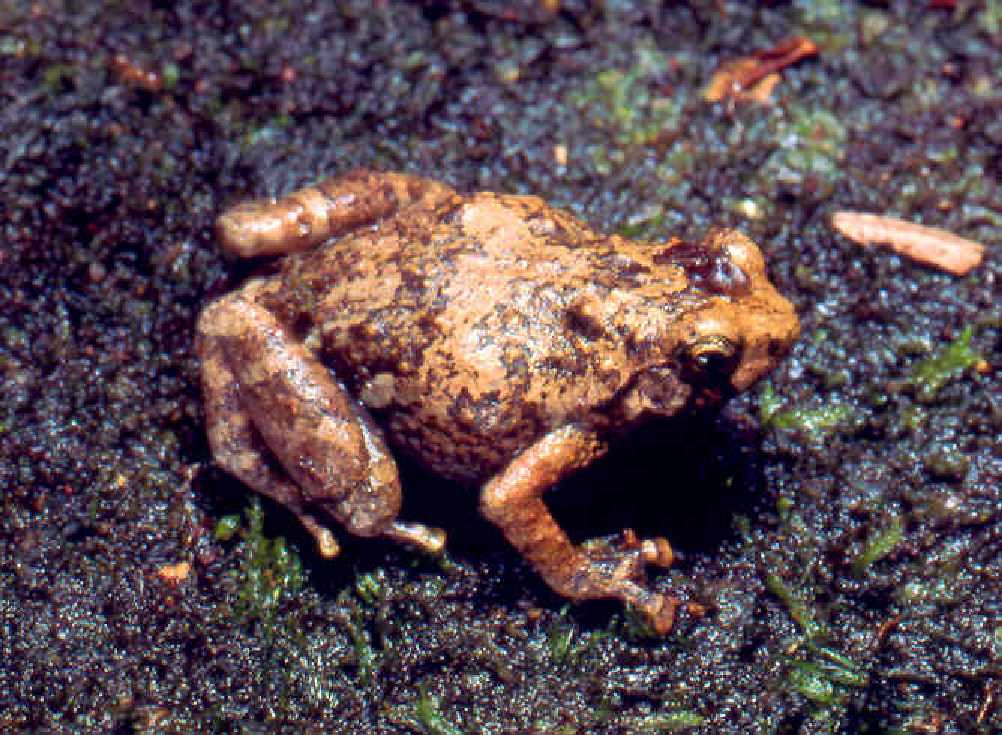
Its natural habitats are subtropical or tropical moist lowland forests, subtropical or tropical moist montane forests, and heavily degraded former forests.
It is threatened by habitat loss due to agriculture, logging, charcoal production, spread of non-native eucalyptus trees, livestock grazing, and human settlement.
The exact population is not known, but it seems to be abundant in the well-managed Andohahela National Park and is less common in the Ambohitantely Reserve, which is not well managed.
Not much more is known about this species.
Cophyla occultans
Cophyla occultans is a species of frog in the family. Microhylidae
It is found on Nosy Be, its type locality, and the adjacent mainland in the northeast of Madagascar, including Ambolokopatrika, Anjanaharibe-Sud, Manantenina, Marojejy, Sambava, and Voloina.
Cophyla occultans is an arboreal species that lives in rainforests. It can also be found in coffee plantations and bamboo cultivation where tree holes and bamboo are available.
Dyscophus antongilii
Dyscophus antongilii, the Madagascar tomato frog, is a frog species from the Microhylidae family.
Females are much larger than males, reaching up to 10.5 cm and 230 g in weight (6.5 cm and 41 g in males).

Females are much larger than males and have brighter red or orange tones on their backs, with a pale underside.
Some individuals also have black spots on their throats.
The bright colors of the tomato frog are believed to serve as a warning to potential predators that these frogs are toxic.
A white substance secreted from the skin acts as a glue to deter predators (such as rainbow snakes) and can cause an allergic reaction in humans.
Habitat and Distribution
Endemic to Madagascar, tomato frogs can be found in the northeastern part of the island around the Antongil Bay (from which they derive their specific name antongilii), and south to Andevoranto.
The exact distribution of this species is unclear, as it is often confused with the closely related D. guineti.
Tomato frogs breed in shallow pools, swamps, and areas with slow-moving water.
These frogs can be found from sea level up to elevations of around 200 m.
Their natural habitats include subtropical or tropical moist lowland forests, rivers, swamps, freshwater marshes, intermittent freshwater marshes, farmland, plantations, rural gardens, urban areas, heavily degraded former forests, ponds, and lakes.
Channels and Ditches.
 Lifecycle and Ecology
Lifecycle and Ecology
Tomato frogs breed in February to March after heavy rains; the sounds of males calling for females to attract them can be heard in the dark Malagasy night around small bodies of water.
After mating, females lay a clutch of 1,000 to 1,500 eggs on the water surface.
From these small black and white eggs, tadpoles hatch about 36 hours later; they are only about six millimeters long and feed through filter feeding.
Tadpoles transform into yellow juveniles, and This stage is completed about 45 days after egg laying.
When hunting for potential prey, adult tomato frogs feed on small invertebrates such as beetles, mosquitoes, and flies.
When threatened, these frogs can inflate themselves and appear larger in size.
 Threats and Protection
Threats and Protection
The tomato frog is classified as “Near Threatened” (NT) on the IUCN Red List and listed in Appendix I of CITES.
The number of tomato frogs has declined due to habitat degradation, environmental pollution, and overcollection of these colorful frogs. Amphibian population decline in the pet trade.
Collection activities and the resulting decline in population were mainly concentrated near the city of Maroantsetra.
In response to this pressure, the tomato frog was quickly listed in Appendix I of the Convention on International Trade in Endangered Species of Wild Fauna and Flora (CITES).
The Baltimore Zoo in the United States has conducted research on breeding methods for the tomato frog in captivity to promote the currently small and genetically disadvantaged captive population in this country.
A consortium of US zoos forming the Madagascar Fauna Group (MFG) has set up an exhibit in Parc. Zoological Ivoloina, Madagascar, was established to bring this attractive member of their natural heritage closer to the local population.
Very little is known about the Tomato Frog, and further research on its distribution, behavior, and potential threats is urgently needed before effective conservation measures can be taken.
Platypelis tsaratananaensis
Platypelis tsaratananaensis is a species of frog from the Microhylidae family. The amphibian is endemic to northern Madagascar.
 Distribution
Distribution
The natural habitat of Platypelis tsaratananaensis is subtropical or tropical moist montane forests.
They inhabit high montane rainforests and bamboo groves and can be found.
Probably not found outside mature forests and likely restricted to elevations above 1,100 meters.
It occurs almost exclusively on bamboo and may benefit from the presence of the Daubentonia madagascariensis (nocturnal lemur) in creating holes in the bamboo.
It breeds in bamboo stems through larval development.
Conservation
It is threatened by habitat loss due to subsistence agriculture, logging, charcoal production, spread of invasive eucalyptus trees, livestock grazing, and expanding human settlements.
Plethodontohyla alluaudi
Plethodontohyla alluaudi is a frog belonging to the Madagascar-endemic subfamily Cophylinae of the family Microhylidae. It is endemic to southeastern Madagascar.
It is a terrestrial and fossorial species.
Frog found in the rainforest, including coastal forests.
Although abundant locally, it is difficult to find.
 Taxonomy
Taxonomy
The species was originally described as Dyscophus alluaudi by Mocquard in 1901, originally described from the locality ‘Fort Dauphin’ – which likely refers to the general area around Tôlanaro rather than the city itself.
It was transferred to the genus Plethodontohyla in 1926, where it remained until transferred by Guibé in 1974 to Mantipus, but returned to Plethodontohyla in 1978.
The taxon Plethodontohyla laevis from further north is On the east coast of Madagascar in 1991, the species P. alluaudi was synonymized.
Blommers-Schlösser assigned a specimen of this species from Mandraka in eastern Madagascar, and subsequent authors also interpreted specimens from the Andasibe area as belonging to this species.
Plethodontohyla alluaudi is a frog belonging to the Madagascar-endemic subfamily Cophylinae of the family Microhylidae. It is endemic to the southeast of Madagascar. It is a terrestrial and fossorial frog found in the rainforest, including coastal forests. Although locally abundant, it is difficult to find.
Rhombophryne coudreaui
Rhombophryne coudreaui is a frog species from the family Microhylidae. He is endemic to the northeast of Madagascar.
The specific name Coudreaui honors Jean Coudreau, a colonial forestry officer in Madagascar who collected the holotype.
Common names for him include Coudreau’s frog and Betampona burrowing frog.
 Description
Description
Females can reach up to 28 mm in length.
The overall appearance is compact with short legs.
The snout is short.
The tympanum is indistinct and measures about 3/4 of the eye diameter. The fingers and toes show traces of webbing. The skin on the back is granular.
The back is light brown. It resembles the Rhombophryne testudo, but lacks the barbels on the lower lip of the latter.
Habitat and Conservation
Rhombophryne coudreaui is found in rainforests, including coastal rainforests, at elevations of 200-1,000 m above sea level.
It is a fossorial and terrestrial species. It is threatened by habitat loss and degradation, especially in coastal rainforests.
It is found in the Betampona Reserve and the Marojejy National Park.
Rhombophryne minuta
Rhombophryne minuta is a frog species from the Microhylidae family. It is endemic to northern Madagascar.
It has been confused with other species like Rhombophryne mangabensis; it is certainly only found in. The Marojejy National Park is well-known for its diverse wildlife and stunning landscapes.
 Description
Description
As the specific name minuta suggests, Rhombophryne minuta is a small species: adult males are about 16-17 mm and females about 22 mm long. The tympanum is indistinct. The dorsal skin is smooth to slightly granular.
The coloration is quite variable; the dorsum is uniformly brown or with dark networks and yellowish spots. The flanks often have small white dots.
There is also a largely yellowish specimen with a broad yellowish midline bordered by a dark line.
The Venter has distinct or indistinct dark networks.
Habitat and Conservation
Rhombophryne minuta are found in lowland and montane rainforests at an altitude of about 1,570 meters above sea level.
It is a fossorial and terrestrial species. Its forest habitat is threatened by subsistence agriculture, logging, charcoal production, spread of invasive species (Eucalyptus), grazing livestock, and expanding human settlements.
Illegal logging has also occurred in the Marojejy National Park.
Rhombophryne serratopalpebrosa
Rhombophryne serratopalpebrosa is a frog species from the Madagascan endemic microhylid subfamily Cophylinae.
Genetic evidence has shown that it is a complex species in need of resolution.
This work has made significant progress, and Between 2014 and 2017, five related species from this complex have been described.
It is threatened by habitat loss.
 Distribution of Rhombophryne serratopalpebrosa.
Distribution of Rhombophryne serratopalpebrosa.
Rhombophryne serratopalpebrosa is endemic to the Marojejy Massif in northern Madagascar. Currently, it is only securely known from the holotype specimen.
Its type locality is at high altitude on the Marojejy Massif.
Records from outside the Marojejy National Park may refer to other species, and so far this species has only been confirmed from this one location.
Description
The holotype of Rhombophryne serratopalpebrosa is approximately 29 mm.
His fingers and toes are not webbed, and his back skin is granular, he has four spines above each eye, the hindmost of which are indistinct.
Rhombophryne vaventy
Rhombophryne vaventy is a large species of frogs belonging to the endemic microhylid subfamily Cophylinae in Madagascar. It is one of the largest members of its genus.
Range and Distribution
Rhombophryne vaventy is endemic to the Marojejy Massif in northern Madagascar, where it was originally described from two individuals captured at high altitude.
 Description
Description
Rhombophryne vaventy can measure up to 52 mm
In life. The dorsal skin of Rhombophryne vaventy is highly textured, with no webbing between its fingers and toes and very long legs. It has four unevenly sized spines above each eye, characteristic of its species group.
Habitat and Ecology:
Rhombophryne vaventy is found in the montane rainforest at high altitudes (~1,300 m above sea level) on the Marojejy Massif. Like most Rhombophryne species, R. vaventy is a terrestrial or possibly semi-fossorial frog. It is a generalist predator, known to feed on relatively large arthrosphaeride millipedes of the genus Zoosphaerium.
Currently, there is no information available about its breeding or calling behavior.
Rhombophryne vaventy was initially confused with R. serratopalpebrosa until the taxonomy of the R. serratopalpebrosa species complex began to unravel.
It differs from R. serratopalpebrosa in its size, eye spines, skin texture, and numerous other characteristics.
The ongoing resolution of this complex has resulted in several new species, including R. ornata and R. tany.
Scaphiophryne boribory
Scaphiophryne boribory is a frog species from the Microhylidae family. It is endemic to eastern Madagascar and only known from the area of its type locality near Fierenana.
Etymology
The specific name Boribory is a Malagasy word meaning “round,” referring to the stout and
The rounded body shape of the species is characteristic.
 Description
Description
Adult males measure 49-60 mm and females 47-59 mm in length.
The body is robust. The head is wider than long, but less wide than the body. The tympanum is not visible and the supratympanic fold is only rudimentary. The arms are moderately slender, while the hind limbs are short and rather stout.
The finger discs are well developed, while the toe discs are only slightly pronounced. The skin is smooth in preserved specimens (except on the throat). The skin appears “oversized”, with a loose and baggy “fit”. The back color is vivid green, with distinctive brown markings with black edges. The finger and toe pads are distinctly reddish. The belly is black with white spots.
Scaphiophryne boribory resembles Scaphiophryne marmorata and Scaphiophryne spinosa, but is larger, lacks warts in the preserved specimens, and has reddish pads on fingers and toes.
 Habitat and Conservation
Habitat and Conservation
Its natural habitats are flooded forest areas on sandy soil. It is believed to breed in swamps.
The elevation of its habitat has been reported differently: around 950 m or 1,000-1,200.
Located in Madagascar, the Scaphiophryne gottlebei is a frog species that inhabits the rainforests of the island. This colorful frog is threatened by the loss of its forest habitat due to subsistence agriculture, livestock grazing, logging, charcoal production, invasive eucalyptus spread, and human settlements.
Another threat to this species is the excessive collection for the international pet trade.
Scaphiophryne gottlebei
The Scaphiophryne gottlebei, commonly known as the Madagascan Rainbow Frog, Rainbow Burrowing Frog, Red Rain Frog, or Gottlebe’s Narrow-mouthed Frog, is one of the most decorated frogs from Madagascar.
The main threats to this endangered species are the loss of its habitat and capture for the (now illegal) pet trade.
Description
The Madagascan rainbow frog is a small, round, brightly colored species with a characteristic white, orange-red, green, and black pattern on its back, with each area clearly delineated.
The skin on the back is very smooth, but that of the gray belly is slightly rough. The snout is rounded, the eyes are protruding, but the eardrums are inconspicuous. The limbs are short and sturdy, the fingers have large tips, and the hind feet are webbed.
The Madagascan rainbow frog is suitable for both underground and climbing sports. It has a strong grip on the underside. The Malagasy Rainbow Frog (Scaphiophryne gottlebei) has cornified warts on its hind feet to facilitate digging, and claws on its front feet to grip vertical canyon walls.
Females, with an average length of 2.6 to 4 cm from snout to throat, are larger and reach a greater maximum size than males, which measure 2 to 3.4 cm.

This frog often spends time in holes or rock crevices.
The Malagasy Rainbow Frog is endemic to the Isalo Massif in Madagascar, at an altitude of 700-1,000 m in the central. Part of southern Madagascar, including the Isalo National Park and areas south of it.
Its primary habitat consists of narrow gorges where the conditions are relatively cool, dark (leading to little or no vegetation), and very humid.
The typical temperature in its habitat is 19-22 °C, but overall it fluctuates between about 13 and 35 °C.
It shares its range with another colorful and endangered frog, the Blue-legged Mantella (Mantella expectata), which inhabits the same habitat but prefers more open, sun-exposed areas.

In the wild, they are detritivores and filter feeders, although in captivity they can feed from Gosner stage 25 to almost full.
These fish were raised on fish food metamorphosis.
They have the unusual habit of spending their days with their heads submerged in the sediment of the bottom, feeding on detritus and with their tails sticking out at an angle. At night, the tadpoles swim around and apparently filter food particles from the open water.
Many tadpoles are washed away by torrents during the rainy season and can complete their metamorphosis elsewhere.
Recently metamorphosed young frogs are about half to a third the size of adult frogs, but otherwise similar.
In addition to the passive dispersal of tadpoles through water currents, adult animals can actively disperse, especially during.
Discover the madagassian rainbow frog, a species that thrives in cold weather.
This species is quite short-lived and typically only reaches an age of 2 years.
Conservation Status
The IUCN lists the madagassian rainbow frog as “endangered”; previously (from 2004 to 2008) it was “critically endangered”, but this was reduced when it was found to be more widespread and locally distributed than previously thought.
Although it is widespread in some areas, it has a limited range, and its population is believed to be declining.
The biggest threats are habitat loss and overcollection for the pet trade. The main dangers to its habitat are deforestation, fires, and. Overgrazing by livestock, mining, and potentially disturbances by tourists.
Still in the 2000s (decade), thousands were caught every year for the pet trade.
With inclusion in CITES Appendix II, an export quota was introduced. By 2014, it had been reduced to 0, making the export of wild-caught animals illegal.
There is evidence that the snake Leioheterodon modestus may be an important natural predator of this frog.
Scaphiophryne marmorata
Scaphiophryne marmorata is a species of frog from the Microhylidae family, commonly known as the green burrowing frog and the marbled rain frog.
It is Scaphiophryne marmorata is endemic to Madagascar. It is classified as “vulnerable” by the IUCN due to the threat of habitat loss.
 Taxonomy
Taxonomy
In 2003, a revision of the Scaphiophryne marmorata complex was conducted, resulting in the removal of Scaphiophryne spinosa from synonymy with Scaphiophryne marmorata and the description of a new species, Scaphiophryne boribory.
Description
The female green burrowing frog grows to about 40 millimeters in length, while the male is smaller at 30 millimeters.
It has an almost spherical shape with a small, flattened head, a short snout, and protruding.
Eyes and well-muscled limbs.
The skin of the back is mostly smooth, but on the upper back there are two symmetrical pairs of bony humps.
The toes on both the front and hind limbs are elongated, helping the frog to climb around in trees and bushes. At the end of the fingers are expanded discs, which are a characteristic feature of this species.
The hind limbs are short with bony flanges on the heels to facilitate digging. The color is a light green, generously speckled with darker green and black spots.
In the western part of their range, the color is more olive green. The subpage is often marbled in white.
 Distribution and Habitat
Distribution and Habitat
The green burrowing frog can be found in the rainforests of eastern Madagascar and in the drier western half of the island. It occurs up to 1,000 meters above sea level.
Biology
The green burrowing frog spends much of its time buried in dead leaves on the forest floor, but when it resurfaces, it often climbs into the branches of bushes and small trees to catch the insects it feeds on.
Regarding the breeding habits of this frog, … Little is known about the green burrowing frog, but it is believed to be an “explosive” breeder, with all frogs in an area coming together simultaneously to mate and lay eggs in temporary pools at the beginning of the rainy season.
The tadpoles likely grow quickly, so they are mature enough to live independently when the pools dry up.
**Status**
The green burrowing frog is listed as “vulnerable” on the IUCN Red List of Threatened Species. This is because, although it is locally abundant, its distribution in Madagascar is small and fragmented, and it is threatened by habitat loss.
and populations appear to be declining.
A small number of individuals are collected for the pet trade, but the possibility of captive breeding is being explored to alleviate this pressure.
This frog has a secure environment in the various national parks where it is found.
The Genus Ranidae
True frogs, the family Ranidae, have the widest distribution of all frog families. They are found in most parts of the world and occur on all continents except Antarctica.
True frogs are found in North America, northern South America, Europe, Africa (including Madagascar), and Asia.
Typically, true frogs are smooth and moist-skinned, with large, muscular legs and extensive webbed feet.
Many of the true frogs are aquatic or live near water.
Most species lay their eggs in water and go through a tadpole stage. However, like most families of frogs, there are significant differences in habitat within the family.
Hoplobatrachus tigerinus
Hoplobatrachus tigerinus, the Indian Bullfrog or Indian Bullfrog, popularly known as the Asian Bullfrog, is a large species of frog found on the mainland of Myanmar, Bangladesh, India, Pakistan, Afghanistan, and Nepal.
It has been introduced to Madagascar and the Andaman Islands. Introduced in India, where it is now a widely spread invasive species.
 Description
Description
Found in India, Bangladesh, Pakistan, Nepal, Myanmar, Afghanistan, and Sri Lanka. They are also present in the Maldives and Madagascar.
They prefer freshwater wetlands and aquatic habitats.
In general, they avoid coastal and forest areas.
Rana tigrina is mostly solitary and nocturnal. They inhabit holes and bushes near permanent water sources.
The frog does not stay in the water for long; it spends most of its time hiding in the. The Indian bullfrog, also known as Hoplobatrachus tigerinus, is a carnivorous amphibian that feeds on various insects, invertebrates, mice, shrews, young frogs, earthworms, roundworms, juvenile snakes, and small birds. It has vomerine teeth in two strongly oblique series starting from the inner anterior angle of the choanae, with the lower jaw having two not very pronounced bony processes at the front.
Its head is moderate in size, with a more or less pointed snout and a blunt canthus rostralis. The nostril is slightly closer to the mouth than to the eye, and the interorbital space is narrower than the upper eyelid. The tympanum is well-defined, about two-thirds the size of the eye.
The Indian bullfrog is known for its ability to blend into its surroundings and ambush its prey. Check out this image of the Indian bullfrog on Wikipedia for a closer look: [Hoplobatrachus tigerinus — Wikipedia](https://upload.wikimedia.org/wikipedia/commons/4/45/HoplobatrachusTigerinus.jpg). The first extends beyond the second; toes moderately webbed, blunt, almost fully covered with webbing; a well-developed fleshy ridge along the fifth toe; subarticular tubercles moderate; inner metatarsal tubercle very variable, small and blunt, strongly compressed, crescent-shaped, shovel-shaped; no outer tubercle, a tarsal fold.
Tibiotarsal joint extending to the ear, eye, or slightly above. Skin of the back with longitudinal folds; a strong fold above the tympanum.
Green or olive green on top, with dark spots; often a light vertebral line. Male with two subgular vocal sacs, externally noticeable by skin folds on the sides of the throat; these regions are generally blackish.
This large frog can have a snout-
Reach a ventilation length of 170 mm.
This species is classified as “Least Concern” in the IUCN Red List.
Ptychadena mascareniensis
The Maskarenian Grass Frog (Ptychadena mascareniensis), or Mascarene Grass Frog, is a species of frog from the Ptychadenidae family. It is found in Africa south of the Sahara, Madagascar, and Mauritius.
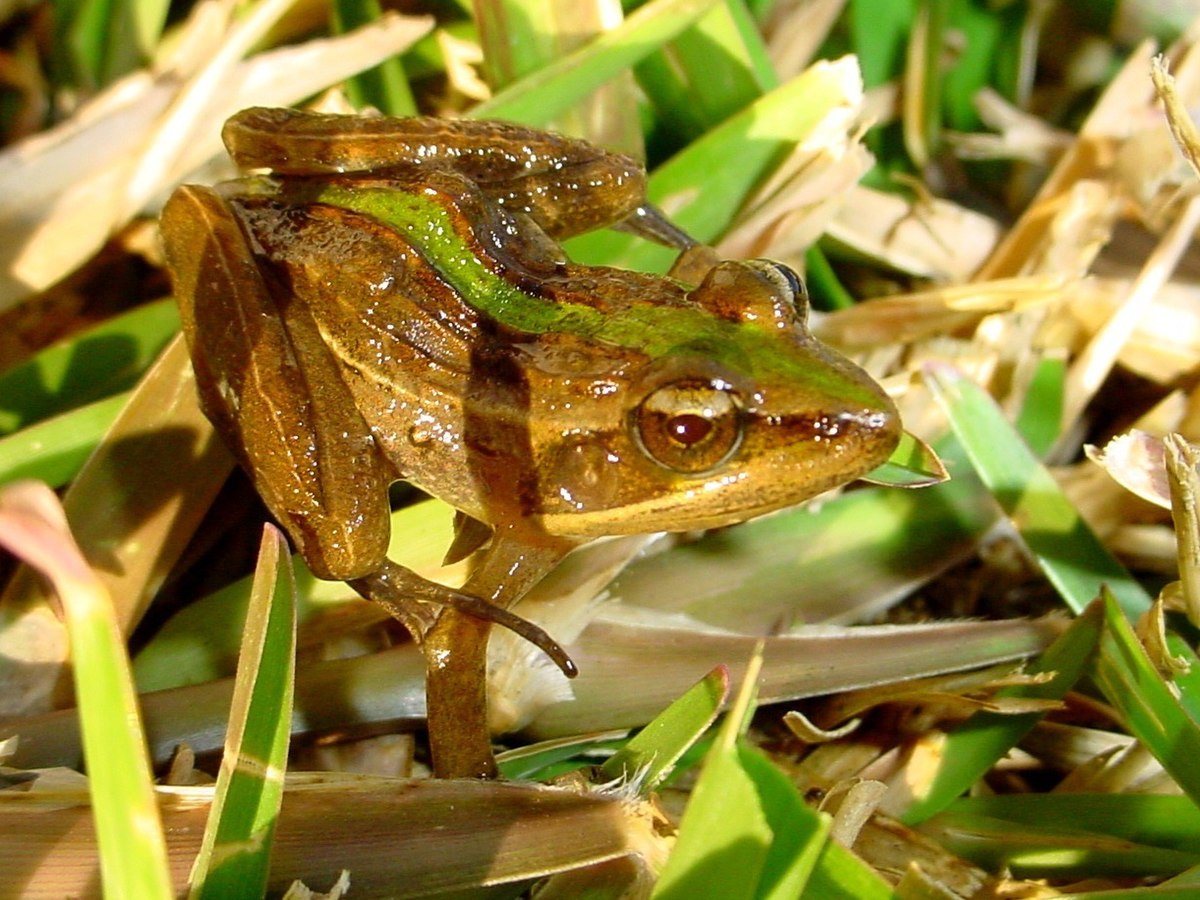
Dry savanna, moist savanna, subtropical or tropical dry shrubland, subtropical or tropical moist shrubland, shrub-like vegetation of the Mediterranean type. Subtropical or tropical dry lowland grassland, subtropical or tropical seasonal wet or flooded lowland grassland, subtropical or tropical highland grassland.
Rivers, isolated rivers, shrub-dominated wetlands, swamps, freshwater lakes, isolated freshwater lakes, freshwater swamps, isolated freshwater swamps, sandbanks, farmland, pastureland, plantations, rural gardens, urban areas, heavily degraded former forests, water reservoirs, ponds, aquaculture ponds, irrigated land, seasonal flooded agricultural areas, as well as canals and ditches.

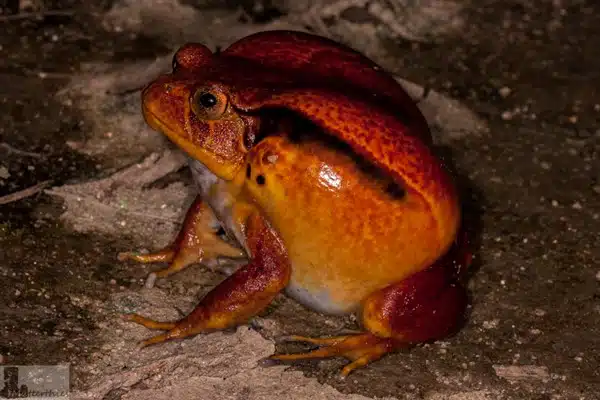
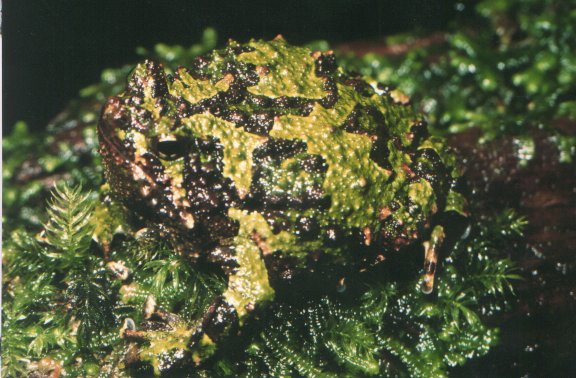 Evolution
Evolution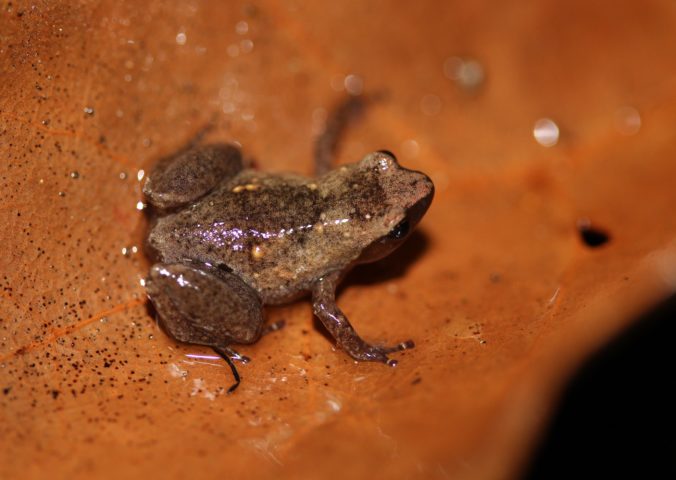 Taxonomy
Taxonomy Description
Description Lifecycle and Ecology
Lifecycle and Ecology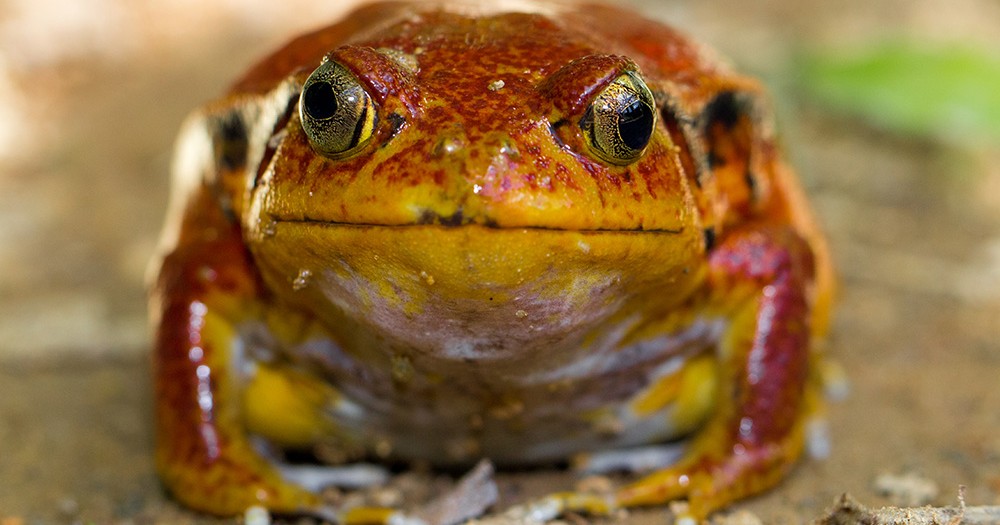 Threats and Protection
Threats and Protection Distribution
Distribution Taxonomy
Taxonomy Description
Description Description
Description Distribution of Rhombophryne serratopalpebrosa.
Distribution of Rhombophryne serratopalpebrosa. Description
Description Description
Description Habitat and Conservation
Habitat and Conservation
 Taxonomy
Taxonomy Distribution and Habitat
Distribution and Habitat Description
Description




